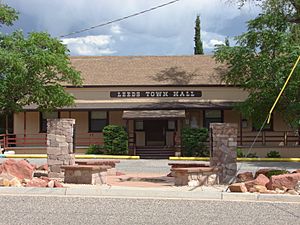Leeds, Utah facts for kids
Quick facts for kids
Leeds, Utah
|
|
|---|---|

Leeds Town Hall
|
|

Location in Washington County and the state of Utah
|
|
| Country | United States |
| State | Utah |
| County | Washington |
| Settled | 1867 |
| Named for | Leeds, England |
| Area | |
| • Total | 6.29 sq mi (16.30 km2) |
| • Land | 6.29 sq mi (16.30 km2) |
| • Water | 0.00 sq mi (0.00 km2) |
| Elevation | 3,504 ft (1,068 m) |
| Population
(2010)
|
|
| • Total | 820 |
| • Density | 138.68/sq mi (53.54/km2) |
| Time zone | UTC-7 (Mountain (MST)) |
| • Summer (DST) | UTC-6 (MDT) |
| ZIP code |
84746
|
| Area code(s) | 435 |
| FIPS code | 49-44100 |
| GNIS feature ID | 2412887 |
Leeds is a small town in Washington County, Utah. It is located in the southwestern part of the state. In 2010, about 820 people lived there. The town is known for its history and its beautiful natural surroundings.
History of Leeds
The town of Leeds was not always called Leeds. It was first known as Bennington. The town was formed in 1867. This happened because of floods in a nearby town called Harrisburg. People living in the flooded areas decided to move to this new, safer location.
Leeds was renamed to honor Leeds in England. Many of the first settlers in the area came from that part of Britain. For a long time, people in Leeds mostly worked in farming.
Today, the town is close to some interesting places. These include the ghost town of Silver Reef, the Pine Valley Mountains, and Zion National Park. Because of these attractions, Leeds has changed. Now, many people work in tourism instead of farming.
Geography and Climate
Leeds is located in a beautiful area of Utah. The town covers about 6.3 square miles (16.3 square kilometers) of land. There is no water area within the town limits.
The Red Cliffs Desert Reserve is right next to Leeds. This reserve helps protect important desert plants and animals.
Leeds Climate
Leeds has a semi-arid climate. This means it is usually dry, but not a true desert. It gets some rain, but not a lot. This type of climate is common in many parts of the western United States.
Population Over Time
| Historical population | |||
|---|---|---|---|
| Census | Pop. | %± | |
| 1890 | 223 | — | |
| 1900 | 248 | 11.2% | |
| 1910 | 148 | −40.3% | |
| 1920 | 211 | 42.6% | |
| 1930 | 220 | 4.3% | |
| 1940 | 268 | 21.8% | |
| 1950 | 166 | −38.1% | |
| 1960 | 109 | −34.3% | |
| 1970 | 151 | 38.5% | |
| 1980 | 218 | 44.4% | |
| 1990 | 254 | 16.5% | |
| 2000 | 547 | 115.4% | |
| 2010 | 820 | 49.9% | |
| 2019 (est.) | 873 | 6.5% | |
| U.S. Decennial Census | |||
The population of Leeds has changed a lot over the years. In 1890, about 223 people lived there. By 1960, the number had dropped to 109. However, the town has grown quite a bit since then.
By the year 2000, Leeds had 547 residents. In 2010, the population grew to 820 people. This shows that more people are choosing to live in this historic Utah town.
See also
 In Spanish: Leeds (Utah) para niños
In Spanish: Leeds (Utah) para niños

